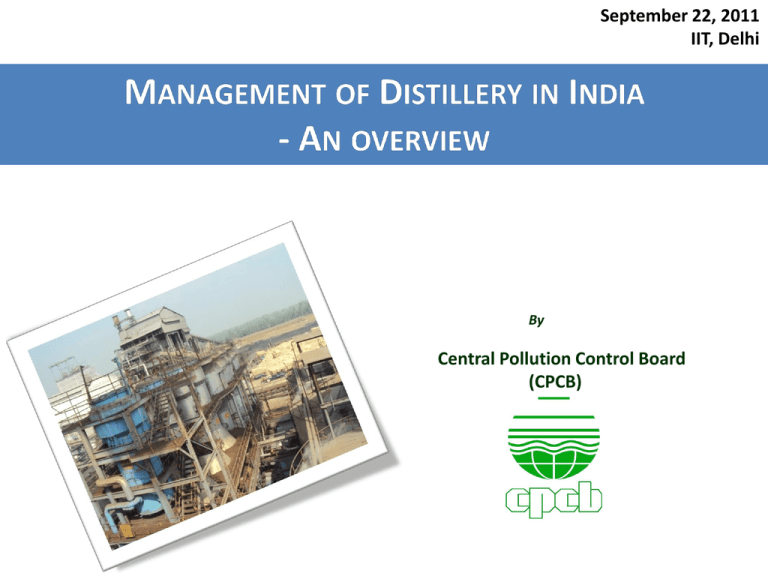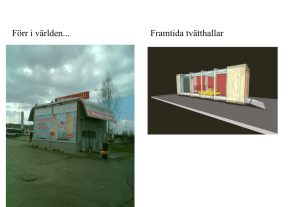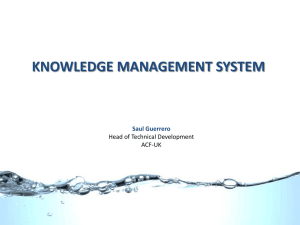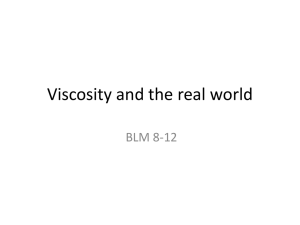Protocols/ Guidelines related to Treatment & Disposal options
advertisement

September 22, 2011
IIT, Delhi
By
Central Pollution Control Board
(CPCB)
In this presentation ....
• Introduction
• Existing standards/ guidelines
• Summary of Compliance Status of Distilleries
• Case studies- Observations from a few distilleries
• Need for revisit
• Emerging Technologies
• Way Forward
Distillery Industry in India
• Number of sugar mills: 620
• Molasses based distilleries – 300
• Molasses based installed capacity : 4.29 bln
lit.
• Gain based distillery units: 100
• Grain based installed capacity : 1.8 bln lit.
• Molasses based distilleries produce spent wash
having very high pollution load
Average fresh water requirement in molasses based distilleries for
different fermentation technologies.
Type of
Fermen
tation
Process
(a)
Molass
es
Dilutio
n fresh
water
(b)
Fresh Non
process
(RS
Production)
Polluted
Streams for
recycle
Unpoll
uted
Strea
ms for
recycle
(g)
Cooling
tower
make
up
Other
non
process *
For
process
For
non
process
(c)
(d)
(e)
(f)
Total
Strea
ms for
recycle
(h)
Total
fresh
water
require-ment
(b+c+
d-h)
Batch
7.4 – 10.5
1.4 – 4.0
6.0 – 8.8
0.5 – 0.6
0.5 – 0.6
0.5 – 1.0
1.5 – 2.2
13.3–
21.1
Cascade
Continuo
us
7.7 – 9.2
3.0 – 4.0
5.5 – 6.5
0.5 – 1.5
0.5 – 0.6
0.5 – 1.0
1.5 – 3.0
14.7–
16.7
Biostill
Continuo
us
4.0 – 5.0
3.0 – 4.0
5.0 – 6.0
2.0 – 4.0
0.5 – 0.6
0.5 – 1.0
3.0 – 5.6
9.0 – 9.4
* Other than cooling tower
Average waste water generation in molasses based distilleries for
different fermentation technologies.
Type of
Fermentation
Process
Waste water generation
Spent wash
Spent lees
Other
Batch
11.1- 15.0
0.5 – 1.5
0.2 –0.4
Cascade
Continuous
8.5 – 11.0
0.5 – 1.5
0.2 –0.4
Biostill
Continuous
6.0 – 8.0
0.5 – 1.5
0.2 –0.4
General characteristics of raw spent wash
S.No.
Parameter
Batch process
Cascade process
Biostil process
1
Volume, L/L Alcohol
14-16
10-12
8-10
2
Colour
Dark brown
Dark brown
Dark brown
3
PH
3.7-4.5
4.0-4.3
4.0-4.2
4
COD
80,000-1,10,000
1,10,000-1,30,000
1,40,000-1,60,000
5
BOD
45,000-50,000
55,000-65,000
60,000-70,000
6
Solid
Total
Total Volatile
Inorganic dissolved
90,000-1,20,000
60,000-70,000
30,000-40,000
1,30,000-1,60,000
60,000-75,000
35,000-45,000
1,60,000-2,10,000
80,000-90,000
60,000-90,000
7
Chlorides
5,000-6,000
6,000-7,500
10,000-12,000
8
Sulphates
4,000-8,000
4,500-8,500
8,000-10,000
9
Total nitrogen
1,000-1,200
1,000-1,400
2,000-2,500
10
Potassium
8,000-12,000
10,000-14,000
20,000-22,000
11
Phosphorus
200-300
300-500
1,600-2,000
12
Sodium
400-600
1,400-1,500
1,200-1,500
13
Calcium
2,000-3,500
4,500-6,000
5,000-6,500
Fermentation Industry : Effluent Discharge Standards
(Distilleries, Maltries & Breweries)
As notified under the Environment (Protection) Rule, 1986
Sr.
No.
Parameter
Range
1
pH
5.5- 9.0
2
Colour & Odour
Absent
3
BOD3 (at 27oC, 3 days) mgs/L Max.
Disposal into land surface water/ 30
rivers/ streams
Disposal on land or for irrigation.
100
4
Suspended solids, mg/L Max.
100
Protocols/ Guidelines related to Treatment & Disposal
options for distillery effluent
CREP Action Points:
• Existing Molasses based Distilleries:
Zero Effluent Discharge (100% by Dec. 2005) through
– Bio-composting,
– Concentration and Incineration
– Biomethanation followed by two stage secondary treatment
followed by ferti-irrigation
– Biomethanation followed by pre-sown irrigation
– Biomethanation followed by treatment and Discharge into
deep sea.
• New Distilleries & Expansion of Existing Distilleries (Molasses
based)
– Zero Effluent Discharge in surface water/ ground water
Protocols/ Guidelines related to Treatment & Disposal
options for distillery effluent
CPCB Resolution (June 2008)
• New stand alone Distilleries:
Concentration – incineration system
• New attached Distilleries:
Bio-methanation followed by bio-composting
Concentration–
incineration
system
{Reboiler/
Evaporation/ Concentration followed by incineration
of concentrated spent wash in boiler (for power
generation)}
• Existing stand alone Distilleries (expansion):
Concentration – incineration system
Protocols/ Guidelines related to Treatment &
Disposal options for distillery effluent
CPCB Resolution (June 2008)
• Distilleries (both stand alone and attached)
not complying with the required
environmental standards to switch over to
emerging technologies from existing
technologies of Ferti-irrigation, One time
land application and composting in a time
bound manner.
Co-Processing of Distillery Spent wash
concentrate in Cement Industry
(CPCB, 2010)
Co-processing of molasses based distillery
spent wash concentrate in Cement Kilns,
furnaces of Thermal Power Plants/ Steel
Plants, Incinerators
Existing Guidelines related to Disposal Options for
Distillery Effluent
• CREP Programme (2002-2003)
–
–
–
–
Ferti-irrigation
One time application (Pre-sown irrigation)
Bio-composting of pre-treated spent wash
Concentration and drying/ Incineration
• Emerging Technologies (2008)
– Evaporation/ Concentration– Incineration system
• Co-processing (2010-2011)
– Co-processing in cement kilns/ furnaces of TPPs/ Steel
Plants.
Ferti-Irrigation Practice
• Biomethanation followed by 2-stage biological treatment to achieve BOD<800 mg/l
• Storage of treated effluent in lagoons with capacity < one fourth of average yearly
utilization of spent wash and impervious liner system (duly lined with 250 micron
HDPE sheet and pitched by stone/bricks with cement mortar to prevent leachate).
• Dilution of treated effluent prior to irrigation to meet critical water quality
parameters, Such as N- requirement of crop, soil type.
• One or more SW irrigations.
• Further irrigations to be done using fresh water
• Application of SW each alternate year
• Command area- radial distance of 20 km
• Distribution network of impervious conduits
• In no case the effluent shall be allowed to flow in earthen channels
Pre-Sown Irrigation Practice
• Use of biomethanated SW of BOD < 7000 mg/L.
• Irrigation application on N-requirement of crop, soil type as
advised by agricultural institutions. N- requirement of the
crop to be applied in a single dose.
• Maximum of one third of the SW generated per year shall be
utilised for pre-sown irrigation.
• Application to be done at least 30 days in advance of sowing
and on set of rains.
• Storage lagoon capacity < one fourth of average yearly
utilization of spent wash
Bio-Composting Practice
•
Open windrows to be 3m long x 2m wide x 1.5m high, with a total volume < 9.0
cu.m.
•
Press-mud as filler material is continuously mixed with pre-treated Spent wash
•
On 30th day, windrow to be broken down and sieved to remove the oversize
contrary material.
•
Screened compost to be stored for about 15 days in heaps about 2m wide x
1.5m high x 20m long to ensure stabilization before sale.
•
Press-mud has an initial C/N ratio of around 20-24, almost stabilized solid
material.
•
Distilleries operate for 270 days.
•
Storage of pre-treated effluent < 30 days
•
As per the specifications, with 850 MT press-mud/ acre, (a) for 45 days cycle,
SW disposal to be 2125 cum (i.e.70 KLD)
Performance Assessment of
Distilleries practicing Fertiirrigation, One time application (Presown irrigation), and Bio-composting
Compliance Status of Distilleries under ESS Programme
Monitoring carried out in more than 100
distilleries, randomly selected, by teams of
scientist & engineers, during the last five years
shows significant violation in more than 60% of
units.
Case Studies- Observations
from a few Distilleries
• 40 to 50% effluent disposal through Biocomposting route.
• Bio-methanation – RO/MEE – Bio-composting.
• Storage of pre-treated/ raw spent wash in lined/
unlined lagoons with capacity > 30 days.
• Inadequate ETP and Non-operational treatment
units.
– Poor Operation & Maintenance of Anaerobic
Digesters
– Non operation of RO/ MEE Plants
Composting process not up to standard:
No composting in operation.
No press mud availability.
No storage sheds for press mud/ final compost.
Open storage of large quantity of unfinished/
finished compost.
Large unlined/ lined areas under compost yard.
No provision for mechanical spray system.
Pit composting technique without any pre-treatment
with unlined/ broken pits.
Unlined bio-composting yard.
No spent wash distribution net work in compost
yard.
No leachate collection system provided to stop the
surface run off from compost yard to nearby water
body/land.
• 50 to 60% effluent disposal through one time land
application/ ferti-irrigation.
• Bio-methanation -- primary clarifier – two-stage extended
aeration system – secondary clarifier -- sludge drying beds
followed by storage of partially treated effluent in lined/
unlined lagoons for ferti-irrigation/ one time land
application.
• Treated spent wash having high BOD requiring high
dilution ration (45 times) resulting in large quantity of
fresh water requirement for irrigation.
• Arrangements with Agriculture Universities for utilization
of treated Spent wash with land availability of 1000 to
3000 hectare.
Completely filled Lined Lagoons with storage
capacity > 3 months.
Completely/ partially filled Unlined lagoons spread
over 3 to 20 hectares land.
Disposal of spent wash with BOD > 20000 mg/l,
COD-80000 mg/l through land application.
Spent wash disposal along with storm water into
nearby river bodies through bypass pipeline or
drains.
Public
complaint
of
ground
water
contamination and regular discharge of
coloured effluent through closed pipe.
Ground water pollution in nearby areas.
Ground water samples indicate contamination
with Colour, TDS and high conductivity.
Demand & Need for revisiting
Guidelines
namely, Ferti-irrigation, Presown irrigation and Bio-composting are not
able to management SW @ equivalent to its
generation rate, resulting in accumulation &
discharge of SW.
Permission for storage of pre-treated SW,
resulted in non-operation of treatment units
like digesters, RO, MEE.
Promote non-conservation of water.
Demand & Need for revisiting
Ferti-irrigation/ Pre-sown irrigation:
High dilution ratio, less no of irrigation
requires large command area, which is not
available to distilleries.
Faulty liner system.
Practically not possible to monitoring and
effective control.
SW irrigation to be employed for about 6 months
in a year only.
Demand & Need for revisiting
Bio-Composting:
• Faulty liner system for compost yard/ storage lagoon.
• Unavailability of large press-mud.
• Unable to handle SW in 1:2.5 to 1:3.5 ratio.
• Existing practices not in accordance with the principle of
composting.
• Practically not possible to monitoring and effective
control.
Emerging Technologies
Established technologies:
1. Anaerobic digestion – Biogas
2. Aerobic surface bio-composting - Bio-compost
3. Reverse osmosis - Permeate/Reject
4. Multiple effect evaporation (Concentration) –
Concentrate/Process condensate
Emerging technologies:
5. Incineration- Spray/ Rotary Dryer, SFB
6. Co-processing
7. Gasification
Emerging Technologies
About 100 distilleries have installed RO plants
About 100 distilleries have installed MEEs
About 30 to 40 incineration plants have been installed.
55 to 60 % solids concentrate or spentwash powder is
fired in a specially designed boiler with or without
subsidiary fuel.
Steam generated runs a TG set to generate electricity.
Exhaust steam is used in distillery and evaporation
plant operations
Potash rich ash as a by-product.
Co-Processing
Co-processing in cement industry refers to the
substitution of primary fuel and raw material by
waste, recovering energy and material from waste.
Waste materials used for co-processing are referred
to as alternative fuels and raw materials (AFR).
Cement Kiln Suitability
High temperatures (1400 O C) and residence time of 4 – 5
seconds in an oxygen–rich atmosphere ensure the
destruction of organic compounds.
Any acid gases formed during combustion are neutralized
by the alkaline raw material and are incorporated into the
cement clinker.
Interaction of the flue gases and the raw material present
in the kiln ensures that the non – combustible part of the
residue is held back in the process and is incorporated
into the clinker in a practically irreversible manner.
No waste is
processing.
generated
that
requires
subsequent
Benefits of Co-processing
Reduction in Green House gases emission
& related benefit of carbon trading
Conversion of waste into energy / as a
raw mix component
Conservation of fossil fuel resource
Reduction in energy / cement production
costs
Department Related Parliamentary Standing
Committee on Commerce
95th Report on
Performance of Cement Industry
The Committee feels that the co-processing of wastes in cement plants that have
successfully been put to trial run need to be commercially implemented. Necessary
guidelines be formed for this purpose. The cement plants should start co-processing of
waste.
JA M M U
AND
K A S H M IR
H IM A C H A L
PRA DESH
PU N JA B
U T TA R A K H A N D
H A R YA N A
ARUNACHAL
PRADESH
DELHI
S IK K IM
U T TA R P R A D E S H
RAJASTHA N
ASSAM
NA GA LAND
M E G H A L AYA
B IH A R
M A N IP U R
W EST
T R IP U R A
G U J A R AT
JHARK HAND
M IZ O R A M
B EN GA L
M A D H YA P R A D E S H
O R IS S A
C H AT T IS G A R H
M AHAR ASH TRA
K A R N ATA K A
ANDHRA
Legend
PRAD ESH
T h e rm al P o w e r
Iron & Ste e l
C e m e nt
D iste lle ry
KERALA
TA M IL N A D U
L O C AT IO N O F C E M E N T, IR O N & S T E E L , D IS T IL L E R Y A N D
THERM AL PO W ER PLANTS
JAM MU
AND
K A S H M IR
H IM A C H A L
G u u rd a sp u r P R A D E S H
A m rits a r
H o sh ia rp u r
P U N J A B B ila sp u r
R upnagar
UnT TA R A K H A N D
F e ro ze p u r S o la
B h a tin d a
D e h ra d u n
P a tia laY.
A mNbaaglaa S a h a ra n p u r
P a nr ipa t M u z a ffa rn a g a r
G anganagar
M ee
Bru
ijnto re
H is a rS
D oEnLip
HaI t
ri M o ra d a b a d
ARUNACHAL
G h a z ia b aDd aGd a
K apsuhr ip u r
jra u la
am
H A RYA
PRADESH
J h aNjhAa r
B u la n dRsh
ahar
F
a
rid
a
b
a
d
D h a ru h e ra
B a re illyL a k h im p u r K h e ri
S IK K IM
a rh
T TA R S h a h ja h a n p u r
A lw aAr ligU
S ita p u r
R A JASTH AN
B a lra m p u r
PRADESH
S ik a r
G o ra k h p u r
ASSAM
L
u
c
k
n
o
w
Jo d h p u r
NAGALAND
o na o n
F a iz a b a d
BBoo nngagiga
a ih
S ita m a rh i
M u z a ffa rp u r
G w a lio r
Kanpur
B a rn e r
K a h a lg a o n
M E G H A L AYA
B a ra n
Jh a n s i
M o k h a mBaa ra u n i
U d a ip u r
B IH A R
M A N IP U R
K o ta
Va ra n a s i
B a n kW
a EST
C h a tta rp u r
S o n e b h a d ra B o ka ro
T R IP U R A
G U J A R AT
S in g ra u li
B irb h u mM u rsh id a b a d
R a jg a rh
M IZ O R A M
JHA R K H A N D
K u tch
R a tla m
B a rd h a m a n K h a y e rp u r
G a n d h in a g a r
K o riy a
P u ru liyB
a a n k u ra
H o o g h lyrpa ra
B E N G A LKUotta
R a ise n
lk a ta
D
h
a
r
Bhavnagar
N o rth 2 4 P a rg a n a s
M A D H YA P R A D E S H
S ipa t K o rb a
A n kle s h w a r
2 4 P a rg a n a s
B ila s p u r
K h a rg o n e
M e d in ip u r
B h a ruN
ch
a n d u rb a r
N a v s aSriu ra t
R a ig a rh
o la N a g p u r
Ja lg a oM
n A HAAkR
ASHTRA
Va p i
Angul
O R IS S A
A u ra n g a b a d
N a s h ik
Thane
J a ln a
C H AT T IS G A R H
A h m e d n a g a r H in g o li
W a s h im
G a n ja m
K h a p o li P u n e
B e e d N iz a m a b a d
R am agundem
S rika ku la m
L a tu r
Nanded
O sm anabad
K a k a tiy a K o ra p u t
V
is
h
a
k h a pa tn a m
M edak
B id a r
ANDHRA
R a tn a g iriS a ta ra S o la p u r
R a n g a re d d y
E
.
G
o
d
a
v
a
ri
S a n g li
S im h a d ri
V ija y w a d aK o th a g u d e m
W . G o d a v a ri
K o lh a p u r
R a ic h u r
K ris h n a
B e lg a u m
GOA
D h a rw a d
C a n a co n a
Legend
B e lla ry
P R A D E S H P ra k a sa m
D a va n g e re
N e llo re
C h itra d u rg a C h ito o r
K A R N ATA K A
Tu m u ku
r
R a y a ls e e
m ava llu r
Tiru
B a n g a lo re
K o la r
M y s o re M a n d y aVe llo re
K a n c h e p u ra m
D h a rm a p u ri
V illu p u ra m
sa le m
P o d ich e rry
K E R A L AE ro d e
C u d d a lo re
h yT h a n ja v u r
C h ittu r C o im b aTric
to
re
TA M IL N A D U
C h a la k u d y
A la p p u z h a
T h e rm a l P o w e r
Iro n & Ste e l
C em ent
D is tille ry
T h e n i S iv a g a n g a
Tiru n e lv e li
T h o o th u k u d i
N o rth -c h e n n a i
K a n jik k o d u
L O C AT IO N O F C E M E N T, IR O N & S T E E L , D IS T IL L E R Y A N D
THERM AL POW ER PLANTS
State wise Distribution of Distilleries, Cement Plants, TPPs and Iron & Steel Industries
Sl.
No.
State
No. of
Distilleries
Molasses based
Distilleries
Total
1
Andhra Pradesh
2
Attach
ed with
Sugar
Mills
No. of
Cement
Plants
No.
No of
of
I&S
TPPs Ind.
34
26
10
20
8
1
Assam
1
1
1
1
1
-
3
Bihar
13
13
3
1
3
-
4
Chhattisgarh
3
6
6
2
5
Daman & Diu
4
-
-
-
6
Delhi
-
-
2
-
7
Goa
4
1
-
-
-
8
Gujarat
18
10
5
9
9
1
9
Haryana
12
7
1
-
3
-
6
-
State wise Distribution of Distilleries, Cement Plants, TPPs and Iron & Steel Industries
Sl.
No.
State
No. of
Distilleries
Molasses based
Distilleries
Total
Attache
d with
Sugar
Mills
No. of
Cement
Plants
No.
of
TPPs
No of
I&S
Ind.
6
-
-
2
-
-
1
5
2
10
Himachal
Pradesh
4
11
Jammu &
Kashmir
6
12
Jharkhand
-
13
Karnataka
43
33
6
9
4
1
14
Kerala
9
8
2
1
-
-
8
Sl.
No.
State
No. of
distille
ries
Molasses based
Distilleries
Total
Attached
with
Sugar
Mills
No. of
Cement
Plants
No.
of
TPPs
No of
I&S
Ind.
15
Madhya
Pradesh
20
20
1
10
4
-
16
Maharashtra
91
75
52
4
12
-
17
Meghalaya
-
3
-
-
18
Nagaland
1
1
-
-
-
19
Orissa
8
8
3
2
3
3
20
Punjab
11
8
3
-
3
-
21
Pondicherry
3
3
-
-
-
22
Rajasthan
16
10
2
16
6
-
23
Sikkim
1
1
-
-
-
-
Sl.
No.
State
No. of
Molasses based No. of
No.
Distiller Distilleries
Cement of
ies/
Plants
TPPs
Breweri
Total
Attach
es
ed with
Sugar
Mills
24
Tamilnadu
25
Tripura
1
26
Uttaranchal
3
3
27
Uttar
Pradesh
61
28
West Bengal
Total
26
21
11
No of
I&S
Ind.
16
7
-
-
-
-
1
-
-
-
56
24
1
11
-
11
7
-
-
14
2
404
326
125
108
102
12
Distilleries vis-à-vis Emerging Technologies
Fermentation & Distillation Industries
400
Molasses based Distilleries
300
Distilleries attached with Sugar Mills
125
Distilleries with Concentrationincineration system
30
Distilleries with MEE system
100
Distilleries directed for adoption of
Emerging Technologies
60
Different treatment technology routes for
distillery effluent/spent wash
•
Biomethanation followed by multi-effect evaporation
followed by drying/ incineration/ co-processing.
•
Biomethanation followed by reverse osmosis followed by
drying/ incineration/ co-processing.
•
Biomethanation followed by reverse osmosis followed by
multiple effect evaporation followed by drying/
incineration/ co-processing.
•
Concentration through RO/ MEE followed by drying/
incineration/ co-processing.
Why Emerging Technologies ?
•
•
•
•
•
•
To attain actual ZLD.
To operate throughout the year
Promotes water conservation (80-90% water
recycled/ reused).
No requirement of storage lagoons and hence
the least chances of pollution.
Co-processing- a more cost effective/ trouble
fee operational option.
Successfully demonstrated in about 30
distilleries.
Way Forward
Distilleries are important for growth and development.
Shifting towards zero liquid discharge paradigm is feasible and must be implemented
to save rivers and help maintain “Nirmal and Aviral Dhara”.
Improvements in technology and following best practices can lead to substantial
reduction in water consumption and lower the cost of attaining zero discharge
paradigm.
Emerging Technologies, namely RO, MEE, Slop fired boilers, Spray/ Rotary Dryers, Coprocessing are capable of attainment of ZLD.
Experience of about 4 to 5 years of operation of emerging technologies are available
with distilleries.
More than 10% of distilleries have adopted emerging technologies
Way Forward
Fiscal and financial schemes may be formulated by Government
Departments and Financial Institutions to support industry.
Expert Committee constituted by CPCB to revisit the effluent &
emission
standards
vis-à-vis
emerging
technologies
implementability & cost economics
Thank You !!








